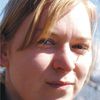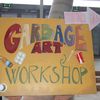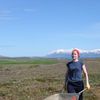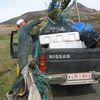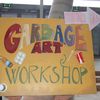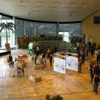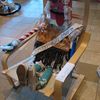Fćrsluflokkur: Bloggar
Fimmtudagur, 28. ágúst 2008
News website !
Hello,
We've got a new website :)
You could now visit us at
http://cleanupthecoastline.wordpress.com
See you soon !
Bless Bless
Ţriđjudagur, 9. október 2007
Conclusion
The conclusion of the Clean Up the Coastline exhibition means that the CUC project is over for 2007. Over the course of the summer, we have cleaned beaches all over Iceland, including the Eastfjords, Westfjords, the North, South and in Reykjavik. The project has been supported by 9 schools in Reykjavik, who provided artwork for the exhibition, Emskip, the Clean Up the World Organisation, the Farmers Association, the Association of Local Authorities in Iceland, the University of Iceland and the Ministry of Environment. A full report of the summer’s activities will be available for download shortly.
Ţriđjudagur, 2. október 2007
Clean Up the Coastline Garbage Artwork exhibition
Between the dates of 15th and 22nd September, the Clean Up the Coastline team held an garbage artwork exhibition in Smáralind’s Winter Garden. The exhibition displayed artwork from various schools in Reykjavik, including Víkurskóli, Fossvogsskóli, Grandaskóli, Korpuskóli, Húsaskóli, Breiđholtskóli, Suđurhiđarskóli, Klébergsskóli and Borgaskóli. In total there were over 80 items of artwork, displayed on fish boxes donated by Emskip.
Two competitions were held during the exhibition, for the best artwork piece and Veraldarvinir’s annual photo competition. Visitors to the display were able to browse and vote for their favorites. The winning schools were Víkurskóli, with ‘Miss Iceland 2007’ and Suđurhlíđarskóli, with ‘Iceland’. The prize is an adventure trip with Veraldarvinir.
In addition to the artwork, there was a children’s area, where it was possible to construct your very own garbage artwork. There were also garbage instruments and the team had great fun inspiring shoppers with some rhythms!
Mánudagur, 24. september 2007
Garbage Artwork Exhibition
On the 15th September, the Clean Up The Coastline team will launch a garbage artwork exhibition, with sculptures created by school children. This will last for 1 week in the Winter Garden, Smáralind shopping center. In addition to the artwork, there will also be photos from Veraldarvinir’s work camps (including entries to the photo competition) and a children’s corner.
The launch event will be on Saturday 15th September at 2pm and will include a musical performance from Fossvogsskóli.
Veraldarvinir will be supported by Víkurskóli, Fossvogsskóli, Grandaskóli, Korpuskóli, Húsaskóli, Breiđholtskóli, Suđurhiđarskóli, Klébergsskóli, Borgaskóli, Landvernd, Náttúruverndarsamtök Íslands, Umhverfisstofnun, Umbúđamiđlun.
Fimmtudagur, 6. september 2007
Garbage large and small...
Polystyrene is a very common plastic used in many everyday objects. The form shown in the picture is Styrofoam, used in packaging. Styrofoam is not recyclable due to being lightweight and of low value. When placed in the environment, Styrofoam can take a long time to decompose, and has been blamed for the starvation of birds.
Fimmtudagur, 6. september 2007
Teaching In Schools
The project so far…
The Clean Up The Coastline team has been busy teaching in schools in Reykjavik and preparing the Clean Up The Coastline exhibition in Smáralind Winter Garden. The school children involved will create artwork from the garbage they find on the beach, which will go on display in the exhibition.
The teaching covers the three main topics below:
How garbage arrives on the coastline?This is done with a giant map of Iceland. The children act out wind, sea, and people throwing garbage from Iceland, UK, America and Russia. They learn that the wind and sea currents move the garbage.
Why garbage is a problem on the coastline?
This is shown through a series of photos of animals in distress so the children can learn about the impacts on nature of garbage at the beach.
How to solve the problem of garbage on the coastline?
The final part of the lesson is about the 3 R’s: Reduce, Reuse and Recycle. The children take part in environmentally friendly shopping, where they have to choose which food products create less waste. They also give ideas for reusing various pieces of garbage, such as cd cases.
The children get the chance to clean a local beach in the afternoon and can find pieces of garbage for their artwork.
Miđvikudagur, 15. ágúst 2007
Garbage Monitoring
Part of the Clean Up the Coastline Project involves garbage monitering. We would like to conduct research related to waste found on the coastline, recording sizes and types of rubbish. Hopefully, we will be able to map out the areas cleaned ready for next years project.
Garbage monitoring involves dividing the coastline into 3 areas 50 metres apart. Each section is 30 x 30 metres. The 3 areas are cleaned, and the rubbish collected is piled up on the beach. Each piece is catergorised according to size and type. The categories include plastic, metal, glass, paper/card, POPs and fishing nets, amongst others.
Ţriđjudagur, 31. júlí 2007
Our progress so far...
We are roughly over half way through the summer workcamp season and so far the Clean Up the Coastline Project has had great success. We have had more than 15 work camps with Clean Up the Coastline activities, and have also carried out some garbage monitering at various locations. The project has been warmly received in communities all over Iceland, and we have been working hard with our local contacts to organise these clean up events. We have many pictures from various different camps, which we will put on the blog.
We have already 2 schools willing to take part, and another 12 more who might be interested in the project. We are also hoping to expand the project to schools in Hafnarfjoerdur and Reykjanesbćr. Veraldavinir is also organising an art festival, Arte Diem, which brings toegther artists from all over the world. They will build art work, and music based on garbage and the Clean Up the Coastline topic. The Clean Up the Coastline team is currently looking for sponsorship from companies in the Reykjavik area for the exhibition.
Miđvikudagur, 18. júlí 2007
A dirty beach in Flateyri
Volunteers taking participating on a camp in Flateyri, in the Westfjords, were amazed when they took part in coastal cleanup activities. The coastline near Flateyri is very dirty, and is full of waste. The problem is escalated by the presence of a landfill site close to the beach. The rubbish is transported from the site to the coastline by wind and streams originating from the mountain. The volunteers put the waste in piles and had to cover it with heavy stones to prevent it from blowing away.
However, it was not possible for the local community to collect this rubbish, despite a rescue attempt with Flateyri's search and rescue team and their boat.
The people in Flateyri have been fighting for many years against having the landfill site in their village, which causes a visual disturbance on the landscape.
Miđvikudagur, 27. júní 2007
Beach Buggies
Many coastal areas are damaged by motor vehicle usage. The picture below shows an area of coastline near Gunnersholmie, South Iceland, being used for recreational purposes. The use of motor vehicles can have a long lasting effect on beach ecosystems: They destroy plants growing in sand dunes. These plants hold the sand together, and provide shelter from the wind. In addition, the drivers of these vehicles often drop litter and waste, and there is always the problem that the vehicles leave behind oil on the beach. The wind in Iceland is sufficent to blow the sand and litter many kilometres away.













